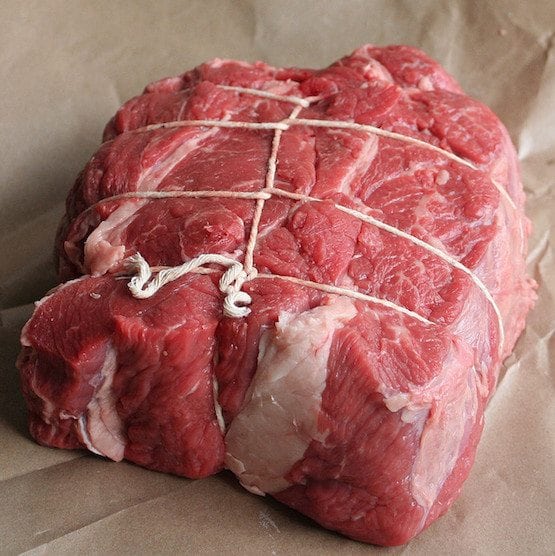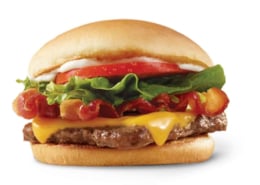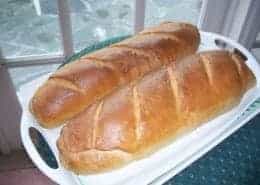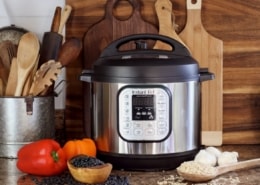Cheap Beef Roast Like Roast Beef

No matter how relatively inexpensive a chuck or round roast may appear, if information technology turns out so tough and flavorless it's passed to the domestic dog, that buy was no deal. That's why everyone on a nutrient budget needs to know how to roast cheaper cuts of beef.
Finally, thanks to very extensive research and experimentation by Christopher Kimball, as reported in Cooks Illustrated magazine*, we can confidently purchase those cheaper cuts and expect perfect results every time.

These days, with beef prices hitting all-time highs, buying the cheaper cuts of beef is one mode to make our food dollars stretch every bit far as possible. Just know that what follows is for those of us with more time than money.
When looking for inexpensive cuts go on these three words in mind: chuck, sirloin, and round. The chuck is fattier and more tender, the round is lean and relatively tough. The sirloin falls somewhere between the two.
Information technology was a kicking to read all the endless details of Chef Kimball's testing. To be quite honest he lost me somewhere between 5 chuck roasts, seven sirloins, eight rounds, and the endless descriptions of cooking methods, internal temperatures, standing times, and length of crumbling.
Curious as I am, I don't care nigh meat fibers, enzymes, and moisture content. And t chapeau'southward when I raced to the conclusion and learned exactly how to prepare a cheap cutting of beefiness. And here it is:
Equipment
To reach the all-time results you lot'll need:
- rimmed baking sail with a wire rack
- meat thermometer (not instant-read but this kind that stays in identify in the roast while cooking)
- oven thermometer (that measures the exact internal temperature of the oven itself)
- cooking twine or string
Ingredients
- 1 boneless beefchuck, sirloin, or circular roast (3 to four.five lbs)
- 4 teaspoons kosher salt, or 2 teaspoons tabular array salt, more or less depending on size of roast
- 2 teaspoons plus 2 tablespoons vegetable oil (divided)
- 2 teaspoons ground blackness pepper
Exact temperatures are the secret to the best results. Interestingly, varying the oven temperature, internal temperature, and times fifty-fifty slightly produced, for Kimball, roasts that were all the way from slightly dry out to so tough they could non exist eaten! Exact temperatures, capiche?!
The Steps
The following steps are for chuck, sirloin, and round cuts of varying size although two- to 5-pound roasts are ideal and will produce the best results.
This process is tedious and y'all'll need to showtime the day before y'all program to serve. Just know that for the coin you'll save and the upshot you will accomplish, it's so worth information technology!

- Tie the roast with white cotton string at i-one/2 inch intervals. Tying the roast tightly makes it compact and shaped evenly and that's the hugger-mugger to even roasting.
- Pat roast dry with paper towels; rub with ii teaspoons oil and generously sprinkle all sides evenly with salt and pepper.
- Wrap tightly with plastic wrap and refrigerate for at least 24 hours.
- Move an oven rack to the eye position. Set oven temp to 250 F.
- Heat remaining tablespoon of oil in a large skillet over medium-high heat until it begins to smoke.
- Remove plastic wrap and sear roast until well-browned on all sides, 3 to 4 minutes per side.
- Transfer roast to a wire rack set in a rimmed baking sail.
- Place the meat thermometer in the roast so the tip reaches the center of the thickest function. Set sheet, rack and roast in oven on its middle rack
- Set the oven thermometer inside the oven close to the pan.
- Roast uncovered at exactly 250 F (keep your middle on it and adjust oven temperature dial as needed to attain exactly 250 F—exercise not depend on the oven'south built-in temperature setting) until the internal temperature of the roast reaches exactly 115 F for rare, 130 F for medium (approximately 2 to 2 1/4 hours for 3 to iv.5 lbs roast).
- Turn oven off simply do non open the door! Leave roast in the oven until the thermometer inserted in the center of the roast registers 130 F for rare, 145 F for medium; information technology volition continue to melt. (If the roast has not reached desired temperature, rut oven back to 250 degrees for five more minutes, plow information technology off.)
- Allow to sit for 30 minutes longer, even so without opening the oven.
- Remove the pan from the oven and permit the meat to balance for 15 minutes. Transfer roast to a carving lath. Slice and serve.
- Reserve any and all juices that have accumulated in the canvas pan to heat and serve with the meal.
At that moment, co-ordinate to Kimball, the roast volition be delicious, tender, juicy, and more flavorful than prepared using any other cooking method. My family and I agree!
*Note:
Christopher Kimball and Cook'south Illustrated parted ways several years agone. Inside days, Kimball founded a new publication, Christopher Kimball's Milk Street. Legal battles ensued. I'm sure in that location were arguments over who endemic legal rights for all of the intellectual properties Kimball created while at Cook's Illustrated. All that to say, if you lot were to search Melt's Illustrated for Kimball's method I've referenced to a higher place, you'd detect a very different version. I can simply guess that Kimball retained rights to much that he created while at Cook's Illustrated, which prompted Cook's to replace information technology with something unlike.
More from Everyday Cheapskate
Delight go on your comments positive, encouraging, helpful, brief,
and on-topic in keeping with EC Commenting Guidelines
Source: https://www.everydaycheapskate.com/roast-cheap-cut-beef/










0 Response to "Cheap Beef Roast Like Roast Beef"
Post a Comment